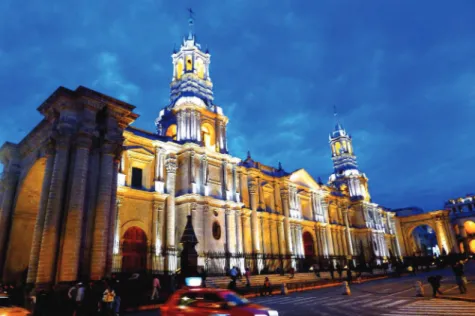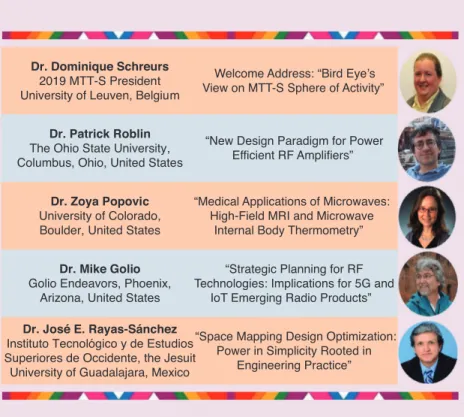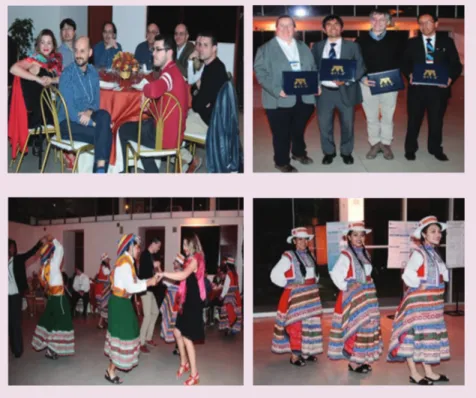The Second IEEE MTT-S Latin America Microwave Conference
T
he second edition of the IEEE Microwave Theory and Tech-niques Society (MTT-S) Lat-in America Microwave Conference (LAMC) was held in Arequipa, Peru, over the second week of December 2018. It was organized by the MTT-S Peru Chapter in Arequipa, Peru (see Figure 1). (The first edition of LAMC took place 12–14 December 2016, in Puerto Vallarta, Mexico, and was a great success.) Following official ap-proval in 2015 of LAMC as a bian-nual MTT-S conference, there were several strategic activities developed in Region 9, such as the creation of new MTT-S Chapters and the organization of several Distinguished Microwave Lecturers (DMLs) visits. Thoseactivi-ties were key to the successful organi-zation of this conference.
At LAMC 2018, we reinforced collab-orations among North America, Europe, Asia-Pacific, and Latin America. Two of the most important people who pro-moted this collaboration, Dr. Thomas Brazil and Dr. Silvio Barbin, passed away only a few months before the 2018 conference, and both were honored during the proceedings.
A joi nt IEEE MTT-S Chapter Chairs Meeting (CCM) and Technical Coordinating Committee (TCC) meet-ing took place on the afternoon prior to the LAMC 2018 inaugural session. This CCM/TCC meeting addressed Latin American volunteers on topics related to MTT-S operations, Young Professionals (YPs) and Women in Microwaves (WiM), new TCC initia-tives, and the MTT-S DML program. Digital Object Identifier 10.1109/MMM.2019.2945217
Date of current version: 2 December 2019
Guillermo Rafael-Valdivia (c16699@utp .edu.pe) is with the Department of Industrial
Engineering at the Universidad Tecnológica del Peru, Arequipa. José E. Rayas-Sánchez (erayas@iteso.mx) is with the Department
of Electronics, Systems, and Informatics, at the Instituto Tecnológico y de Estudios
Superiores de Occidente, the Jesuit University of Guadalajara, Mexico.
■ Guillermo Rafael-Valdivia and José E. Rayas-Sánchez
©IS
TOCKPHO
TO
.COM/T
OBIA
We also discussed alternatives for future LAMCs (see Figure 2).
On the opening day of the con-ference, Dr. Dominique Schreurs, 2019 MTT-S president, presented the opening address, “Bird Eye’s View of MTT-S Sphere of Activity.” Schreurs welcomed female professors and researchers to become part of the WiM group, as shown in Figure 3.
In total, 97 papers were submitted to the conference from Belgium, Germany, France, India, Pakistan, Russia, Spain, and the United States as well as from countries in Latin America, includ-ing Argentina, Bolivia, Brazil, Chile, Colombia, Mexico, Peru, and Puerto Rico. In all, 71 papers were approved for presentation, including eight invited papers for the special sessions.
Attendees presenting accepted papers were invited to submit ex-tended versions to the LAMC mini special issue of IEEE Transactions on Microwave Theory and Techniques. Twenty papers were submitted for this mini special issue and, after a rigorous review process, six contributions were accepted for publication in this presti-gious journal.
With more than 150 participants, the technical program for LAMC 2018 included the following:
• five keynote speakers: Domi-nique Schreurs, Patrick Roblin, Zoya Popovic, Mike Golio, and Jose Er nesto Rayas-Sá nc hez (see Figure 4)
Figure 1. The main cathedral of Arequipa, the host city of LAMC 2018. (Source: José Luis Bustamante Alvarez; used with permission.)
Figure 2. IEEE Chapter chairs and members of the TCC participate during the joint CCM/TCC meeting during LAMC 2018.
• one workshop: RF Capture of Medical Telemetry: Learn-Build-Diagnose, which took place imme-diately preceding the conference and was conducted by MTT-S YPs and the IEEE Special Interest Group on Humanitarian Tech-nology (SIGHT). Attendees were presented with ways to develop a
system capable of receiving and decoding radio packets of medical telemetry. This workshop focused on low-cost access to medical di-agnostics and telemetry using software-defined radio technology for the periodic measurement of blood glucose for diabetes moni-toring (see Figure 5)
• an industry exhibition led by gold sponsor Copper Mountain Technologies, Inc.
• a contest for postgraduate students • a special session about microwave
research and technology activi-ties in Spain, organized by Prof. Miguel Laso from the Universi-dad Pública de Navarra, Spain. LAMC 2018’s regular oral sessions were organized into the following technical topics (see Figure 6):
• passive components and circuits • active devices, circuits, and
sub-systems
• RF systems and applications • communication systems • active antennas
• signal-power integrity
• CAD techniques for RF and mi-crowave engineering.
Separate from the regular ses-sions, there was a two-day industry exhibition that included high-tech companies such as Copper Mountain Technologies from the United States and Cerro Verde and Claro from Peru, representing state-of-the art RF and microwave engineering in the region (see Figure 7).
A welcome reception was offered on the first day, including traditional serenades performed by a group o f Peruvian students (called Tuna) dressed in traditional clothes. The reception was held at Los Claustros
Figure 5. The RF Capture of Medical Telemetry: Learn-Build-Diagnose workshop coordinated by MTT-S YPs and SIGHT members. Dr. Dominique Schreurs
2019 MTT-S President University of Leuven, Belgium
Welcome Address: “Bird Eye’s View on MTT-S Sphere of Activity”
Dr. Patrick Roblin
The Ohio State University, Columbus, Ohio, United States
“New Design Paradigm for Power Efficient RF Amplifiers”
Dr. Zoya Popovic
University of Colorado, Boulder, United States
“Medical Applications of Microwaves: High-Field MRI and Microwave
Internal Body Thermometry”
Dr. Mike Golio
Golio Endeavors, Phoenix, Arizona, United States
“Strategic Planning for RF Technologies: Implications for 5G and
IoT Emerging Radio Products”
Dr. José E. Rayas-Sánchez
Instituto Tecnológico y de Estudios Superiores de Occidente, the Jesuit
University of Guadalajara, Mexico
“Space Mapping Design Optimization: Power in Simplicity Rooted in
Engineering Practice”
de la Compañia, a well-known tour-ist site in Arequipa (see Figure 8). On the second day, our gala dinner took place in the main auditorium of the host institution, the Catholic University of Saint Pablo (see Figure 9). During dinner, a traditional Peruvian folk dance from the Colca Valley called wititis was introduced. Taking the form of a courtship ritual, it is typically performed by young people during religious festivities celebrated throughout the rainy season. Guests were invited to dance and enjoyed each other’s company. We think that all these activities align with the motto of LAMC 2018: “A friendly uni-verse inspired by microwaves.”
(a) (b)
Figure 8. (a) The welcome reception and (b) a performance by Tuna.
(a) (b)
Figure 6. (a) LAMC 2018 technical sessions and (b) networking.
To archive each version of LAMC, we created (with support from the MTT-S) a repository where the evolu-tion of this conference over the years can be observed, along with many photos and valuable information for future organizers. The repository can be viewed at https://lamc-ieee.org/.
Finally, we would like to cor-dially invite the entire MTT-S com-munity to join us for the next edition of this emerging conference, LAMC 2020, to be held in Cali, Colombia, in December 2020.
In all, 71 papers
were approved
for presentation,
including eight
invited papers
for the special
sessions.
Figure 9. Scenes from the LAMC 2018 gala dinner.
Microwave Surfing
(continued from page 14)
he saw an aerial photograph showing the foundations of a Gallo-Roman theatre buried under a field just up the road. Although barely discernable, the m a rk i ng s i n t he f ield showed the outline of the first century AD building and he r e c k o n e d t he sem ici rc u la r structure bore an uncanny re-semblance to one half of an in-visibility cloak.
Brûlé has discovered similar features in the foundational structures of the Colosseum in Rome [3].
So, did the Roman engineers know about metamaterials and their role in cloaking structures against the vio-lent seismic waves of an earthquake? As physicist Greg Gbur noted [3],
I doubt that the builders of struc-tures in that era intentionally
designed their buildings to be earthquake resistant, or even that they were able to unconsciously evolve their designs over time to make them more secure— the time scales seem too short. I could imagine, however, that there might be a sort of “natural selection” that occurred, where megastructures built with in-advertent earthquake cloaking might have survived longer than their counterparts, allowing us to see their remains now.
Does this archeological find have an application in the design of tomorrow’s smart cities? Brûlé and his colleagues have developed computer models to show “how skyscrapers arranged in a circle could act as an invisibility cloak that creates a safe zone at its center” [4]. Urban planners, please take note.
References
[1] R. Bansal, “What goes up …,” IEEE Antennas
Propag. Mag., vol. 42, no. 3, pp. 102–103, June 2000.
[2] E. Cartlidge, “ Did the Romans build seismic invisibility cloaks?” Physics World. Accessed on: Sept. 9, 2019. [Online]. Available: https:// physicsworld.com/a/did-the-romans-build -seismic-invisibility-cloaks/
[3] J. Ouellette, “Study says ancient Romans may have built ‘invisibility cloaks’ into structures,”
Ars Technica. Accessed on: Sept. 9, 2019. [On-line]. Available: https://arstechnica.com/ science/2019/05/study-says-ancient-romans-may -have-built-invisibility-cloaks-into-structures/ [4] Emerging Technology from the arXiv, “
Ro-man amphitheaters act like seismic invis-ibility cloaks,” MIT Technology Review, May 29, 2019. Accessed on: Sept. 9, 2019. [Online]. Available: https://www.technologyreview .com/s/613550/roman-amphitheaters-act -like-seismic-invisibility-cloaks/



